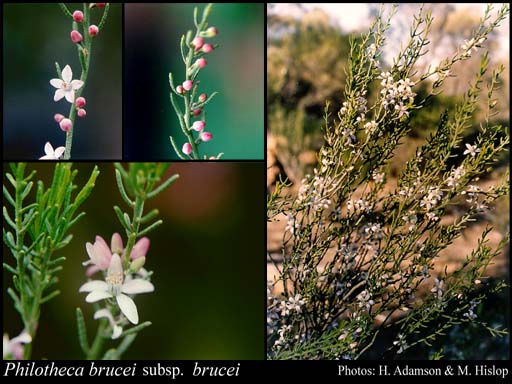- Conservation Code
- Not threatened
- Naturalised Status
- Native to Western Australia
- Name Status
- Current
Erect or straggling shrub, 0.3-2 m high, leaves sub-terete. Fl. pink/white, Apr to Sep. Red sandy & loamy soils. Rocky outcrops & hills, breakaways.

Scientific Description
Shrub, spines absent; branchlets verrucose (warty), +/- cylindrical in cross-section, glabrous. Leaves alternate, simple, 5-15 mm long, 1-2 mm wide, terete, verrucose (warty), glabrous. Flowers axillary, solitary; pedicels 0.5-5 mm long; calyx present, 1-2.5 mm long, smooth, without distinct raised glands, glabrous; corolla pink or white or cream, petals five, 5-6 mm long, imbricate (overlapping), free, glabrous; stamens twice as many as petals, 2-3 mm long, smooth, ciliate (with a marginal fringe of hairs); anthers 1-1.2 mm long, with an appendage. Flowers in April, May, June, July, August and September. Occurs in the Eremaean and South-West Botanical Province, in the Great Victoria Desert, Coolgardie, Avon Wheatbelt and Geraldton IBRA region(s).
Distribution
- IBRA Regions
- Avon Wheatbelt, Coolgardie, Geraldton Sandplains, Great Victoria Desert, Jarrah Forest, Murchison, Yalgoo.
- IBRA Subregions
- Eastern Goldfield, Eastern Murchison, Edel, Geraldton Hills, Lesueur Sandplain, Merredin, Northern Jarrah Forest, Shield, Southern Cross, Tallering, Western Murchison.
- Local Government Areas (LGAs)
- Chapman Valley, Coolgardie, Coorow, Cue, Dalwallinu, Greater Geraldton, Kalgoorlie-Boulder, Koorda, Laverton, Leonora, Menzies, Moora, Morawa, Mount Magnet, Mount Marshall, Mukinbudin, Murchison, Northampton, Perenjori, Sandstone, Victoria Plains, Westonia, Wiluna, Yalgoo, Yilgarn.